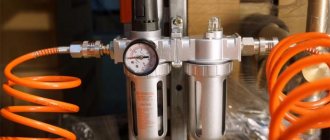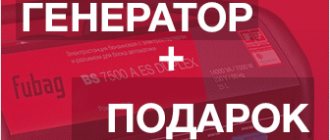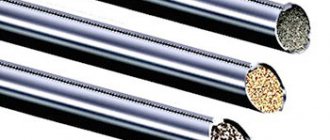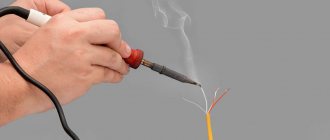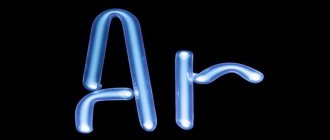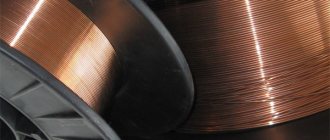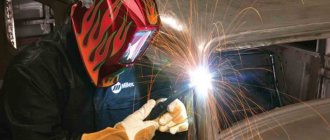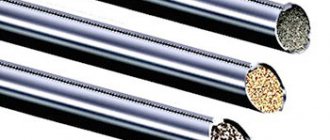What the article is about:
Who is flux-cored wire suitable for, and who should not use it?
Semi-automatic welding has a number of significant advantages. Firstly, the speed of welding work increases significantly. Secondly, there is no slag during welding. You can weld long seams without interruption. Thirdly, this is more delicate work with workpieces that are very thin.
The only thing needed for semi-automatic welding is shielding gas. But what if there is no protective gas? How to cook semi-automatically without gas? In fact, there is a way out, and its name is “cored wire”.
Flux-cored self-shielding wire independently takes on the task of protecting the weld pool. That is, if in the usual case, when welding with a semi-automatic machine, gas is needed for this, then, without using it, you can weld with only flux-cored wire.
How does cored wire work and how does it work?
Everything is simple here. To protect the weld pool, a gas of substances contained in the flux-cored wire is used. The wire itself is made of metal, in the form of a tube, inside of which there is a special filling. When the metal of the tube melts, substances that form a gas cloud to protect the weld pool are also burned.
A conventional electrode in the form of a metal rod works in exactly the same way. On its surface there is also a coating of special substances that, when burned, form a cloud of protective gas. When welding semi-automatically with carbon dioxide, there is none of this, and only carbon dioxide acts as a shielding gas. I hope I expressed myself in accessible words and everything fell into place.
So, you can cook semi-automatically without gas if you have cored wire. Who is this method of semi-automatic welding suitable for, and in what cases?
Rating of the best brands of welding wire
Here are the most common brands available in the Russian Federation. They are preferred by professional welders and amateurs.
| Nomination | Place | Name | Rating |
| Rating of the best brands of welding wire | 1 | ESAB | 5.0 |
| 2 | Svarog | 4.9 | |
| 3 | Fubag | 4.8 | |
| 4 | Brima | 4.7 | |
| 5 | Wester | 4.6 | |
| 6 | Quattro Elementi | 4.5 | |
| 7 | Solaris | 4.4 | |
| 8 | FoxWeld | 4.3 | |
| 9 | Deka | 4.2 | |
| 10 | Elitech | 4.1 | |
| 11 | Cedar | 4.0 | |
| 12 | Kraton | 3.9 |
When to weld with flux-cored wire without gas
In principle, you can always cook; in such cases there is no need for protective gas. The only drawback is the price; it is quite high for self-shielding wire for a semi-automatic machine, so not everyone can afford to weld with cored wire every day.
The second point is related to the fact that it is not always possible to deliver gas cylinders to the welding site. Well, let's say you need to cook at a height. How to deliver a carbon dioxide cylinder there? That's right, it will be better and faster to weld semi-automatically using flux-cored wire.
The next point is related to weather conditions. As you know, the main enemy of semi-automatic welding is the wind. If the weather is windy outside, the shielding gas will simply blow off, which will negatively affect the quality of semi-automatic welding.
Consequently, cored wire will also help get rid of this problem; it can be welded even in very windy weather.
Welding process
Once the equipment is set up and all recommendations are taken into account, you can proceed directly to welding.
To avoid the appearance of deformation and cracks, a gap is left between the parts along the entire length for expansion. The parts are secured in a vice or other way and clamped in several places.
You need to start with minimal consumption of shielding gas. Turn off the wire feed and adjust the gas flow rate to operating mode using the valve on the reducer. Then direct the gas flow to the workpiece and blow through its surface in literally 3-5 seconds.
At the beginning of welding, you need to look at the seam. If pores form, increase the gas supply until they no longer appear. Gas consumption must be adjusted to economical mode. So that the quality of the seam does not suffer.
You need to start cooking 5-6mm away from the edge to prevent cracks from forming. The torch nozzle should be angled slightly back in the direction of the seam and at a height of 10-12mm above the welding joint.
If the angle is tilted forward, the weld width increases and the penetration of the welding arc decreases, which is good for thin sheets.
Welding speed
The speed at which the electric arc moves along the welding site is controlled by the welder. Too high - it can cause a lot of splashes and melting of the metal, while the protective gas does not have time to escape and pores form. Insufficient speed is the reason for changes in the penetration of the welding arc into the parts being welded.
You need to cook with a short arc - this is when the distance between the end of the wire and the surface of the molten metal is 0.5-1.5 mm. Boiled in this way, the seam has the correct outline, a smooth and convex surface.
Another method of welding thin parts is pull-off welding, i.e. short circuits of the arc gap. Press the trigger and release, and gradually fill the joint with a thread seam (rollers).
If the device has a pulse function, then it is better to work on it. Pulses generated by a short circuit in the welding machine are used to melt the metal.
When welding thin (up to 3mm) stainless steel with a semi-automatic machine, guide the torch nozzle along the seam, avoiding transverse movements. Otherwise, there is a possibility of molten metal leaving the protective environment zone. It is better to weld thin parts in a vertical position, moving from top to bottom.
If two workpieces are of different thickness, then keep the nozzle on the thick one. With an instant movement, move the torch to the thin workpiece and return to the thick one again. Otherwise, the thin metal will burn out.
To avoid serious defects during welding, it is worth using ceramic pads, which are self-adhesive tape. They are most suitable for working with thin parts, as well as in awkward spatial positions.
When is it better to refuse welding with self-shielding wire?
There are only two drawbacks here - the high cost and lower quality of the weld than when welding semi-automatically in a shielding gas environment. Flux-cored wire has also performed rather poorly when welding pipes under pressure. Therefore, this method is not at all suitable for performing these works.
In general, as you can see, there are pros and cons when using self-shielding wire. The advantages are associated with the ability to weld in hard-to-reach places and in any weather, and the disadvantages are with the high price and lower quality of the seam.
Preparatory work
Before cooking stainless steel with a semi-automatic machine, careful preparation is required:
- Clean work surfaces until shiny;
- degrease parts with acetone or any organic solvent;
- if the metal thickness is more than 4 mm, process the ends so that a small space is formed between them for filling with metal;
- warming up the parts to 100, remove excess moisture;
- heat the metal to 200 to relieve internal stress.
In production, to remove surface contaminants: carbon deposits, traces of grease, rust, parts and wires are etched with a solution of hydrochloric or sulfuric acid. After this, rinse with hot and cold water and dry.
The flow rate of the gas mixture at an operating pressure of 0.2 atmospheres using a reducer is set within the range of 6-12 m3/min. Failure to comply with these indicators reduces the quality of the seam.
Adjustment of current and voltage depends on the power of the device.
The penetration depth, arc length, and weld shape depend on these parameters. As the current increases, the deposited weld becomes wider, and the welding depth decreases.
Some settings for a semi-automatic welding machine:
| Metal thickness, mm | Wire diameter, mm | Gap when butt welding parts, mm | Current strength, A | Welding voltage, V |
| 1 | 0,8 | 0 | 65 | 17 |
| 1,5 | 0,8 | 0 | 115 | 17 |
| 2 | 0,8 | 0,5 | 130 | 17,5 |
| 3 | 1 | 1 | 210 –215 | 18 |
| 4 | 1 – 1,2 | 1,5 – 2,5 | 220 – 280 | 20 |
| 5 | 1,2 | 2,5 | 190 – 300 | 21 |
| 6 | 1,2 | 2,5 | 300 | 22 |
Each machine is supplied with a table of welding modes. The master selects the semi-automatic operating mode, depending on the welding parameters. After setting up the machine, weld on a test piece. If necessary, adjust the settings.
Requirements for consumables and their advantages
Flux-cored wire used for arc welding is produced in accordance with the basic requirements:
- With the creation of uniform melting of the material without large splashes;
- Stable heating and easy arc initiation;
- The result should be a neat seam, without defects (pores and cracks);
- The slag formed during melting should be evenly distributed along the seam and separated upon cooling.
Such requirements are the main parameters for welding materials and determine the use of flux-cored wire when welding steel under different conditions.
Welding of powder steel helps solve construction and production problems, increases the productivity of the process, and reduces the labor intensity of manual cleaning of products from splashes. Depending on the type of use and protection from external factors, the wire can be gas-protective or self-protective.
Connection of stainless steel and black steel
Welding of such materials is carried out at direct current. The position of the wire is strictly perpendicular to the working area.
Stainless steel wire must contain manganese and nickel, for example, ESAB OK, Autrod. A special transition wire deposits a buffer layer, which connects the parts.
When welding St40 steel to stainless steel, you can use 08G2S wire. This strengthens the seam between two dissimilar metals after cooling. The most important thing in the process is that the stainless steel does not become too fluid, and the ferrous metal does not remain solid. The seam is made as wide and as deep as possible.
Advantages
- No additional use of flux or its calculation in a certain proportion is required;
- The welding process becomes better and the percentage of defects decreases;
- The use of wire becomes simpler and more efficient;
- Many negative nuances of difficult-to-weld metals fade into the background thanks to correctly selected additional consumables;
- The connection speeds up, since welding with flux-cored wire allows it to come into contact with the base metal faster;
- For automatic devices, this is one of the best options, which guarantees a more reliable connection;
- There is no risk that any extra elements will get into the molten seam with the flux.
Material markings
To make it clear what specific wire needs to be purchased for welding work, there is a marking that determines the composition and purpose.
For example, when purchasing consumables for a semi-automatic machine, you see the following marking - CB-08G2S. What does it mean?
SV - nomenclature designating the welding purpose of the wire.
08 is the percentage of carbon in the composition, in this case 0.08%.
G2 means that this material contains 2% manganese.
C - contains at least 0.5% silicon.
Based on this marking, it can be understood that this consumable has alloyed elements, is low-carbon and is suitable for cooking the corresponding materials.
What alloying elements can be included in welding consumables?
If, instead of the designation SV, there is a combination of NP, this means that such a material is intended for surfacing and it is not practical to use it in welding. Also, the markings in front may contain such designations as A or AA. In the first case, this means that the composition contains high quality steel, in the second - the most refined steel.
Advantages and disadvantages
The undoubted advantages of semi-automatic welding of stainless steel:
- High performance combined with high-quality connection;
- low smoke emission, which protects health and the environment;
- slight metal spattering due to automatic wire feeding;
- versatility - you can weld workpieces of different thicknesses, as well as dissimilar metals.
One significant drawback is the bulky gas cylinder. These are additional costs for its acquisition and inconvenient movement.
The spread of the method became possible with the development of technology and process automation. Mainly used in industry for large-scale production. Working with a semi-automatic welding machine, although it requires certain knowledge and skills, still remains one of the popular types of metal processing. You can learn more about how to operate a semi-automatic welding machine in our article.
Features of the method
The connection of metal parts using semi-automatic welding occurs as a result of the continuous supply of a fusible electrode. A hollow tube of a certain diameter acts as an electrode. Melting occurs from an electric arc.
In industry, there are two ways of operating a semi-automatic machine:
- the use of a gas environment is necessary subject to the requirement of protecting the seam from oxygen;
- welding without gas frees the welder from the difficulties associated with moving equipment, as well as constantly replenishing the container.
In order to avoid labor costs, it is recommended to use semi-automatic welding without a gas environment. A flexible tube is used; the material has a cavity inside; during the manufacturing process, the void is filled with flux, it is heated, and gas is released. The seam is protected from the action of foreign substances. The benefits include:
- powering the device from the central network using wires;
- mobility of the device;
- continuous supply without stopping to replace the electrode.

